Romulus Resources Page
The resources on this page are intended as supplemental material for
Lesson #1: Men or Myths?
Origin Story
Have you read about the Trojan War yet? Believe it or not, it’s where the story of Romulus begins!
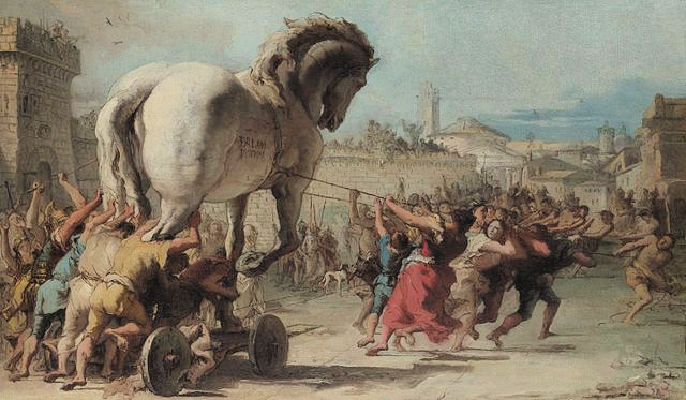
Public domain image, Wikipedia Commons.
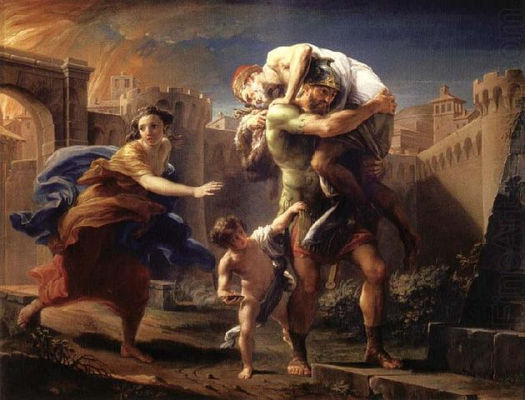
Public domain image, Wikipedia Commons.
Here’s an article about Helen, Queen of Sparta: “Helen of Troy: The Face that Launched a Thousand Ships” from ThoughtCo.
And here are some of my favorite retellings of the Trojan War:
But was Troy a Real City?
You can see the World UNESCO site for the Archeological evidence of Troy here.
Here’s an article to tell you more about the archeological evidence of Troy: “In Search of Troy” from the Smithsonian Musuem.
Lesson #2: The She-Wolf
Take a virtual tour of the Salla della Lupa (Hall of the She-Wolf) of the Capitoline Museum Gallery via Google Arts here.
The Vestal Virgins
Vesta is the goddess of the hearth, home, and family in the religion of ancient Rome. Only her priestesses, the Vestal Virgins, were allowed in Vesta’s temple where they tended the sacred fire.
There were 6 Vestal Virgins, chosen between the ages of 6 and 10, who then served as priestesses for 30 years.

Public domain image, Wikipedia Commons.
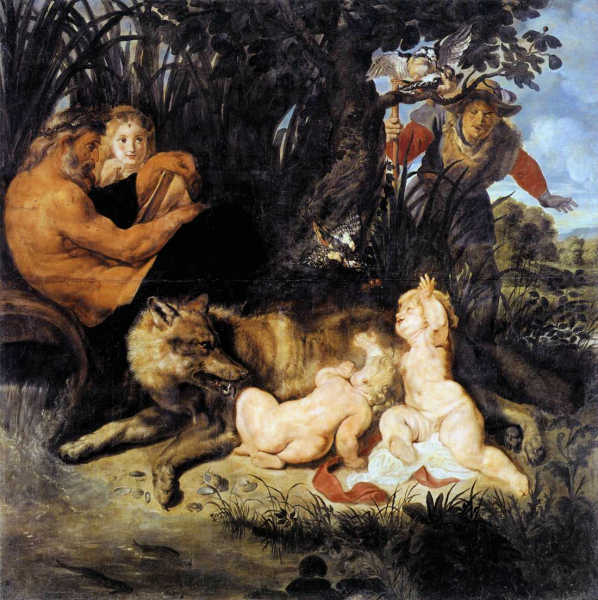
Public domain image, Wikipedia Commons.
Lesson #4: The Founding of Rome
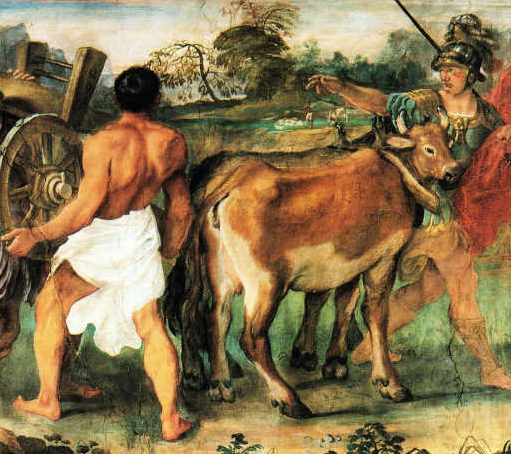
Public domain image, Wikipedia Commons
This painting is just one of 14 frescos that tell the Stories of the Founding of Rome.
As part of A Plutarch Picture Study: The Life Romulus, you can learn more about all 14 frescos on the Picture Study Resources page for Romulus here.
Auspicious Augury

Want to learn more about the “auspicious” beginning of Rome? Read this article from Prayers and Piazzas: “Of Birds, Brothers and Beginnings: The Birth of Rome”
You can read more about the vultures of Europe at the Discover Wildlife website here.
The Oracle of Delphi: The Most Powerful Woman of Ancient Greece
In ancient Greece, the Pythian Oracle was the high priestess of the Temple of Apollo at Delphi. She was also known as the Oracle of Delphi and as the Pythoness.
Apollo was the god of prophecy and was seen as a source of guidance. As a result, the ancient Greeks built many sites for the oracles of Apollo. The Oracle of Delphi became the most well-known and influential of all the oracles. People would come from far and wide to consult her.
The Oracle of Delphi was the most prestigious and authoritative oracle among the ancients Greeks, and she was one of the most powerful women in the classical world.
The Oracle of Delphi is one of the best-documented religious institutions of the classical Greeks. Authors who have mentioned her include Aristotle, Diogenes, Euripides, Herodotus, Livy, Plato, Sophocles, Thucydides, and of course, Plutarch.
You can read more about the Pythia in this interesting article by The Conversation: “Hidden Women of History: The Priestess Pythia at The Delphic Oracle, Who Spoke Truth to Power”
Delphi: The Center of the World
The ancient Greeks considered Delphi to be the center of the world. Located on Mount Parnassus, it was named after the Delphyne, a she-serpent Drakaina who lived there (in other accounts the serpent was the male serpent, Drakon or Python).
According to Greek mythology, the hill was guarded by the serpent, who was a follower of the Earth goddess Gaia. Apollo claimed Delphi as his own sanctuary after killing the serpent.
The Pythia became Apollo’s high priestess and his mouthpiece through whom he gave prophecies.
The name Pythia is derived from the Greek verb púthein “to rot,” which refers to the sickly sweet smell from the decomposing body of the monstrous Python after it was slain by Apollo.
Ode to a King: The Galerie d’Apollon
The Galerie d’Apollon (Apollo Gallery) within the Louvre Museum is dedicated to the god Apollo. The gilded hall was commissioned by King Louis XIV of France.
King Louis XIV famously identified himself with the sun god Apollo and this splendid gallery was the first tangible representation of that image. To create this masterpiece of architectural decoration, he summoned the greatest painters, gilders and sculptors of the day, who later worked on the Hall of Mirrors at the Château de Versailles.
– Louvre Museum website
Below you can see the painting Apollo Slays the Python by Eugène Delacroix on the ceiling of the Galerie d’Apollon.
You can see more of the Galerie d’Apollon on the Louvre’s website here or in the video below.
Plutarch at Delphi
Did you know? Plutarch was a Priest at Delphi.
Around 95 CE, Plutarch was appointed as one of the two sanctuary priests for the temple of Apollo at Delphi.
His priestly duties connected with his writings. In his book, Moralia, Plutarch wrote two articles about the Pythia: “Why Pythia Does Not Give Oracles in Verse” and “On the ‘E’ at Delphi.”
Delphi Today
You can visit the archeological site of Delphi here: UNESCO Archeological Site of Delphi
Lesson #5: The Abduction of the Sabine Women
The legend of the abduction of the Sabine women in ancient Rome is a disturbing one, to say the least.
How does Plutarch treat the subject as he retells the legend? Please see the study questions for this lesson in both resources:

Public domain image, Wikipedia commons.
As part of A Plutarch Picture Study: The Life Romulus, you can learn more about this painting and several others regarding Lesson #5 on the Picture Study Resources page for Romulus here.
Sabine, Not Sobbin'
This story is the subject of a song called “Sobbin’ Women” in the 1954 movie Seven Brides for Seven Brothers.
The movie was based on the short story “The Sobbin’ Women” by Stephen Vincent Benét, which was based on the ancient Roman legend of the abduction of the Sabine women.
You can see the song in the video below. How much of the story as portrayed in the song is incorrect? Compare and contrast the attitudes regarding the treatment of women in ancient Rome, the 1954 movie, and the present-day.
The Circus Maximus
The Circus Maximus was the first and largest stadium in ancient Rome. It could hold more than 150,000 spectators and was the site of chariot races.
According to Livy’s History of Rome, the Circus Maximus was built by the 5th king of Rome, Lucius Tarquinius Priscus, also known as Tarquin the Elder. Later kings and emperors added to it.
Learn more about the artwork for Lesson #5 on the Picture Study Resources page for Romulus.
Lesson #7: The Intervention of the Sabine Women
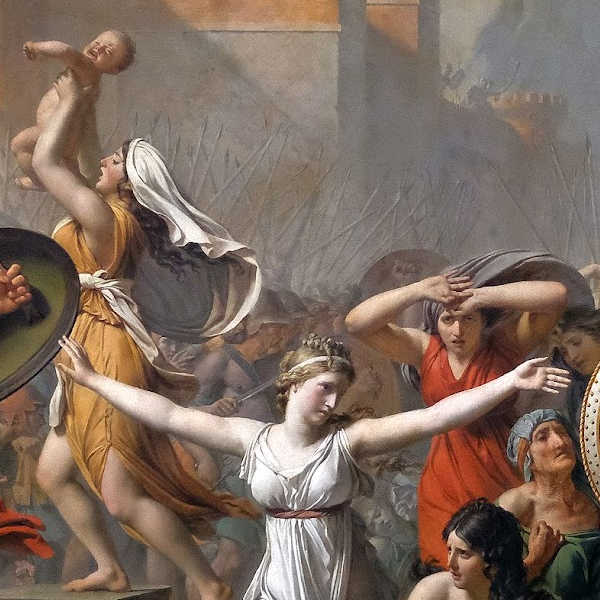
Public domain image, Wikipedia commons.
The above image is a detail from David’s Intervention of the Sabine Women.
For more information about this painting, see the Plutarch Picture Study Resources page for Romulus.
The Life of Romulus
A Plutarch Picture Study
There's more to explore with A Plutarch Picture Study for Romulus!
Click Here for Private Artwork ResourcesLesson #8: The Romans and Sabines Make Peace
You can read more about Roman togas in this ThoughtCo article: The 6 Types of Togas Worn in Ancient Rome
You can read more about the Lupercalia festival in this article by the American Shakespeare Center: “You know it is the Feast of Lupercal”: February Traditions Now and Then.

Public domain image, Wikipedia commons.
Lesson #9: A Murder and a Plague
In this lesson, Plutarch says there was “blood rain” with the plague.
According to a study published in the journal Phylogenetics and Evolutionary Biology, blood rain can be caused by the presence of the microalgae Trentepohlia annulata.
Other scientists say it can also be caused by dust particles in the air.
You can learn more about this strange phenomenon on Wikipedia: Blood Rain or in this article by the Met Office, a weather forecasting service in the UK: Blood Rain.
Or watch the video below.
Besides a murder and a plague, this chapter also recounts several laws that Romulus enacted.
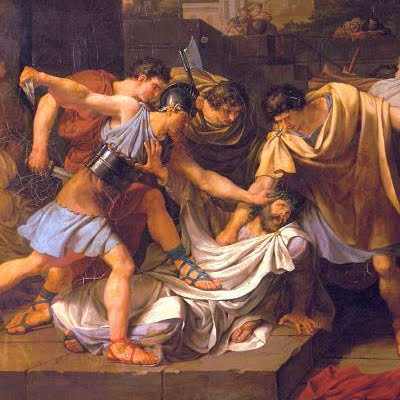
Public domain image, Wikipedia commons.
The image above is a detail from La Mort de Tatius by Jacques Réattu.
For more information about this painting and others, see the Plutarch Picture Study Resources page for Romulus.
The Life of Romulus
A Plutarch Picture Study
There's more to explore with A Plutarch Picture Study for Romulus!
Click Here for Private Artwork ResourcesLesson #10: Romulus Quirinus
In this lesson, Plutarch mentions the Battle of Zama which was fought between Rome and Carthage and led by the great military leaders Scipio Africanus and Hannibal, respectively.
The image below shows one artist’s depiction of the battle.
You can read more about Scipio and Hannibal on the Heritage History website.
The Battle of Zama
The Roman and Carthaginian forces were said to have been quite equal in manpower when they eventually met face-to-face at the Battle of Zama in 202 BCE.
A Roman historian named Livy (59 BCE-17 CE) dramatically described the scale and consequential nature of the battle:
“[T]o decide this great issue, the two most famous generals and the two mightiest armies of the two wealthiest nations in the world advanced to battle, doomed either to crown or to destroy the many triumphs each had won in the past” (Livy, Roman History, 30.32).
In the ensuing showdown, Scipio’s cavalry advantage proved vital, whereas Hannibal’s elephants apparently did less harm to the Romans than they did to his own army.
The Greek historian, Polybius (c. 200-118 BCE), described the battle:
“Since they were equally matched not only in numbers but also in courage, in warlike spirit and in weapons, the issue hung for a long while in the balance. Many fell on both sides, fighting with fierce determination where they stood, but at length the [Roman aligned] squadrons of Masinissa and Laelius returned from their pursuit of the Carthaginian cavalry and arrived by a stroke of fortune at the crucial moment. When they charged Hannibal’s troops from the rear, the greater number of his men were cut down in their ranks, while of those who took to flight only a few escaped…” (Polybius, The Histories, 15.14).
Hannibal was one of the Carthaginians who lived to fight another day. Yet, after Zama, Carthage was compelled to sue for peace with Rome. In the ensuing negotiations, Carthage was forced to dismantle its navy, pay hefty quantities of war reparations, and formally cede Carthaginian territory in Spain to the control of the Romans.
Such is the history behind the artwork featured above.
- C. Keith Hansley, The Historian Hut
Lesson #11: Enduring Symbol of Rome
I hope you have enjoyed learning about Romulus and the founding of Rome.
If you’d like to read Virgil’s Aeneid, I’ve listed two retellings that I like below as well as a translation of the full book if you’d like to dive into the original epic poem!
As always, keep learning!
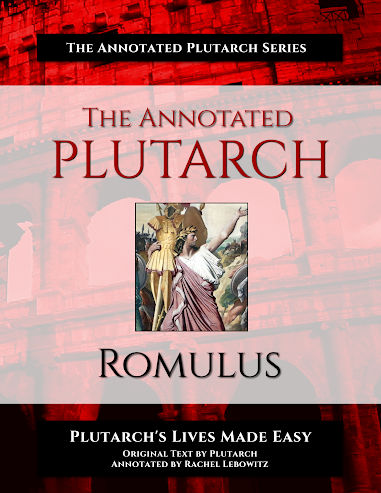
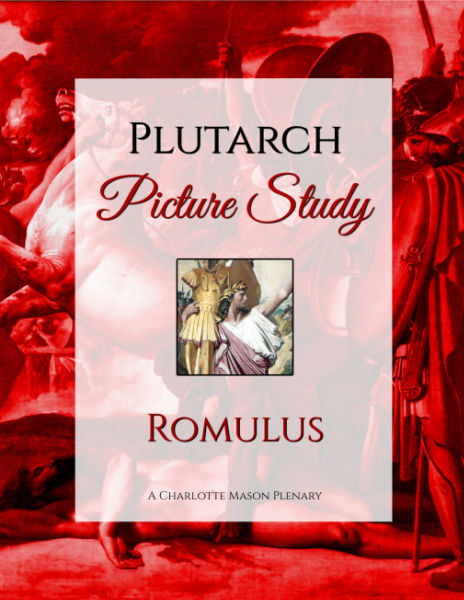




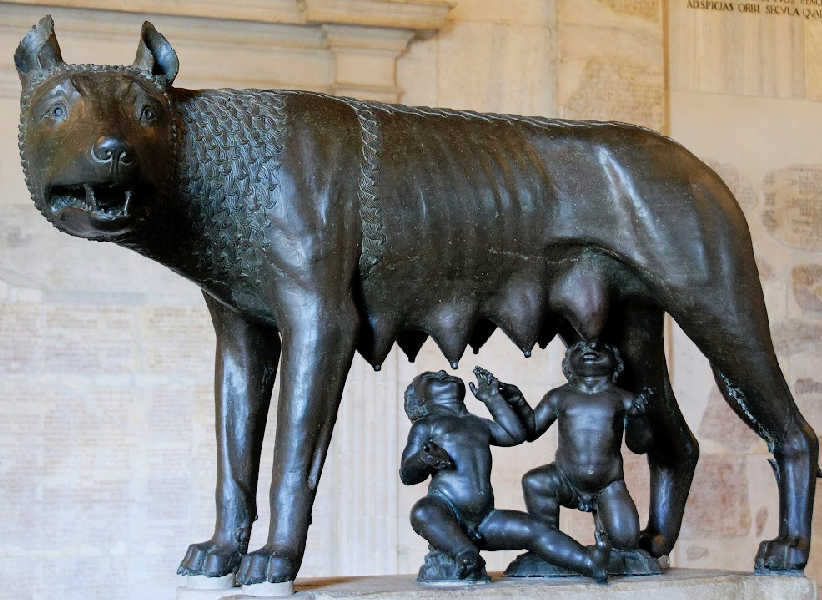
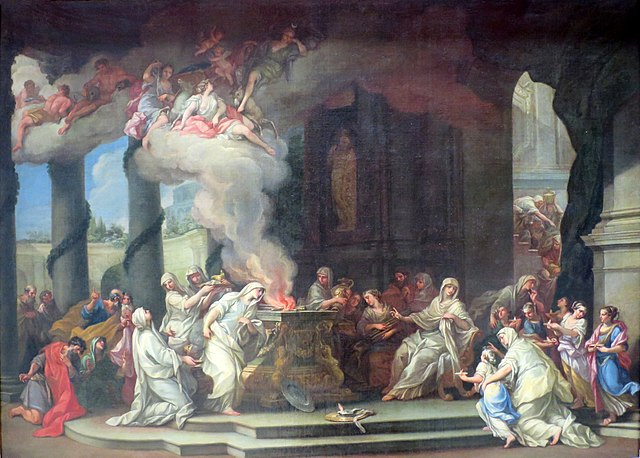



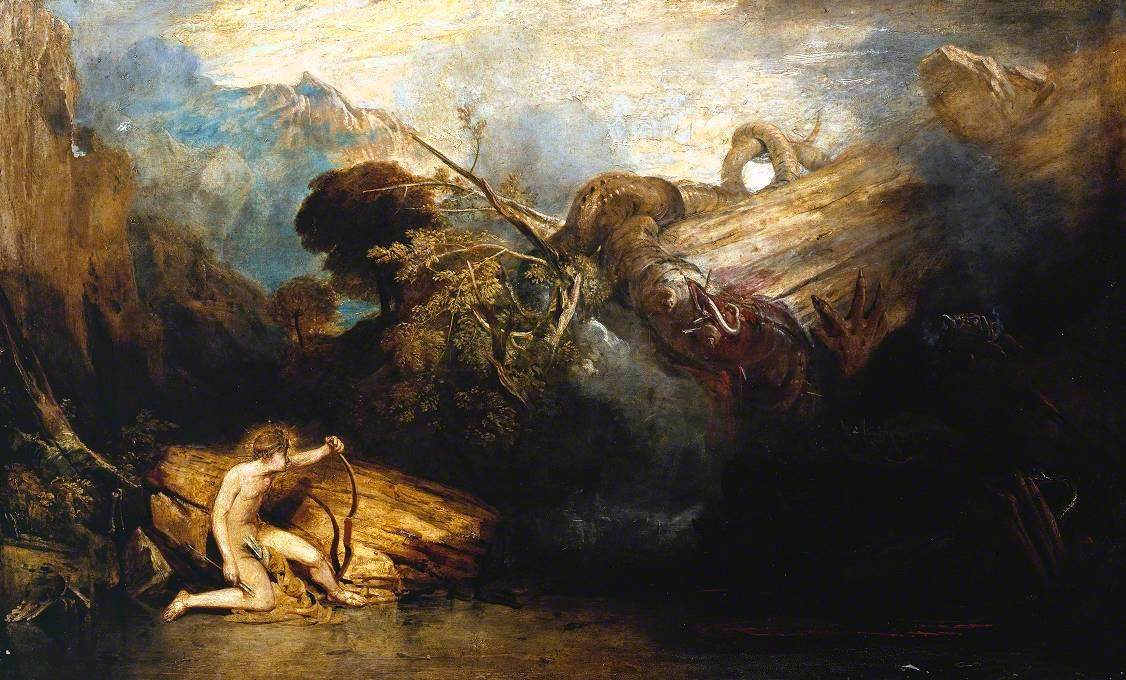





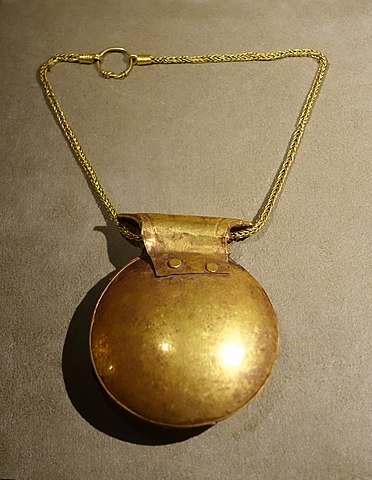
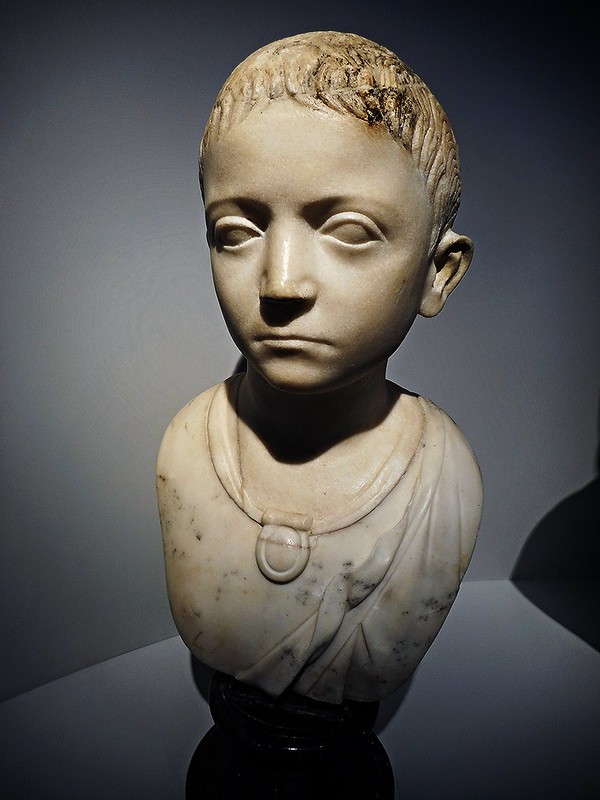





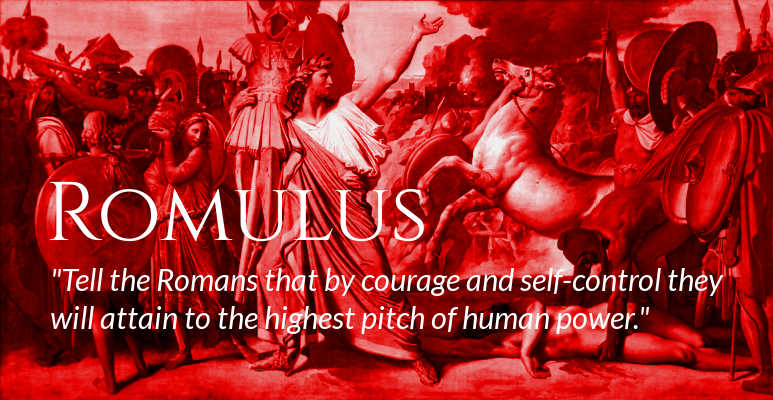
0 Comments for “Romulus Resources”